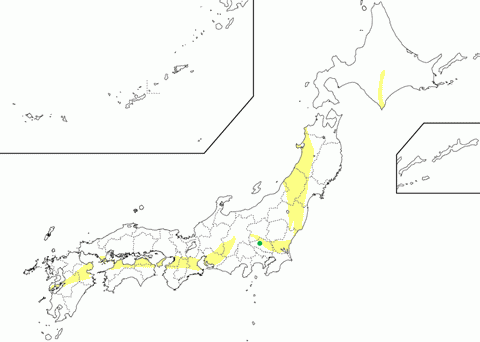Muscovite-Rare-element Pegmatite
Chemical Process (Liquid-phase Growth) - Closed system under ground (Melt precipitation)
Abbreviation
MSREL
Classification
Muscovite-Rare-element class < Granitic pegmatite
Required Geological Setting
Middle-pressure metamorphic rocks, Low-pressure metamorphic rocks
Occurrence
Pegmatite associated with upper Amphibolite facies in Barrovian-type middle-P metamorphism or Ryoke-type low-P metamorphism. Formation condition is 580-650 degree and 0.2-0.5 GPa (5-12 km depth). Pegmatites are associated with S-type granites or I-type granites intruded in metamorphic rocks subjected to Amphibolite facies metamorphism, and mineral assemblages include those of Muscovite Pegmatite and Rare-element Pegmatite. Pegmatites are usually disconcordant with schistose textures of host metamorphic rocks subjected to Amphibolite facies metamorphism. Pegmatites are massive and pockets are very rare. This class is classified into 2 subclasses based on its mineral assemblages; MSREL-REE and MSREL-Li. Pegmatites associated with Ryoke-type low-P metamorphism have unique mineral assemblages, and are tentatively separated as MSREL-Al subclass.

Distribution of muscovite-rare-element pegmatites described in this site. Red is ilmenite-series granites corresponding to S-type granites, and blue is magnetite-series granites corresponding to I-type granites.
Mineral Assemblages (Major minerals)
Quartz, Microcline, Albite, Muscovite
Mineral Assemblages (MSREL-REE subclass)
Beryl, Fergusonite-(Y), Samarskite-(Y), Monazite-(Ce), Almandine, Spessartine
Mineral Assemblages (MSREL-Li subclass)
Beryl, Cassiterite, Columbite-(Fe), Lepidolite, (Spodumene)
Mineral Assemblages (MSREL-Al subclass)
Andalusite, Cordierite, Almandine
Localities
- Takato (Andalusite)
- Mandokoro (Muscovite)
Related Occurrences
- Pegmatite (Abyssal)
- Pegmatite (Muscovite)
- Pegmatite (Muscovite-Rare element)
- Pegmatite (Rare element, Allanite)
- Pegmatite (Rare element, Euxenite)
- Pegmatite (Rare element, Gadolinite)
- Pegmatite (Rare element, Titanium)
- Pegmatite (Rare element, Beryl)
- Pegmatite (Rare element, Phosphate)
- Pegmatite (Rare element, Spodumene)
- Pegmatite (Rare element, Petalite)
- Pegmatite (Rare element, Lepidolite)
- Pegmatite (Rare element, Elbaite)
- Pegmatite (Rare element, Amblygonite)
- Pegmatite (Rare element, Albite-Spodumene)
- Pegmatite (Rare element, Albite)
- Pegmatite (Miarolitic, REE)
- Pegmatite (Miarolitic, Li)
- Pegmatite (Gabbro)